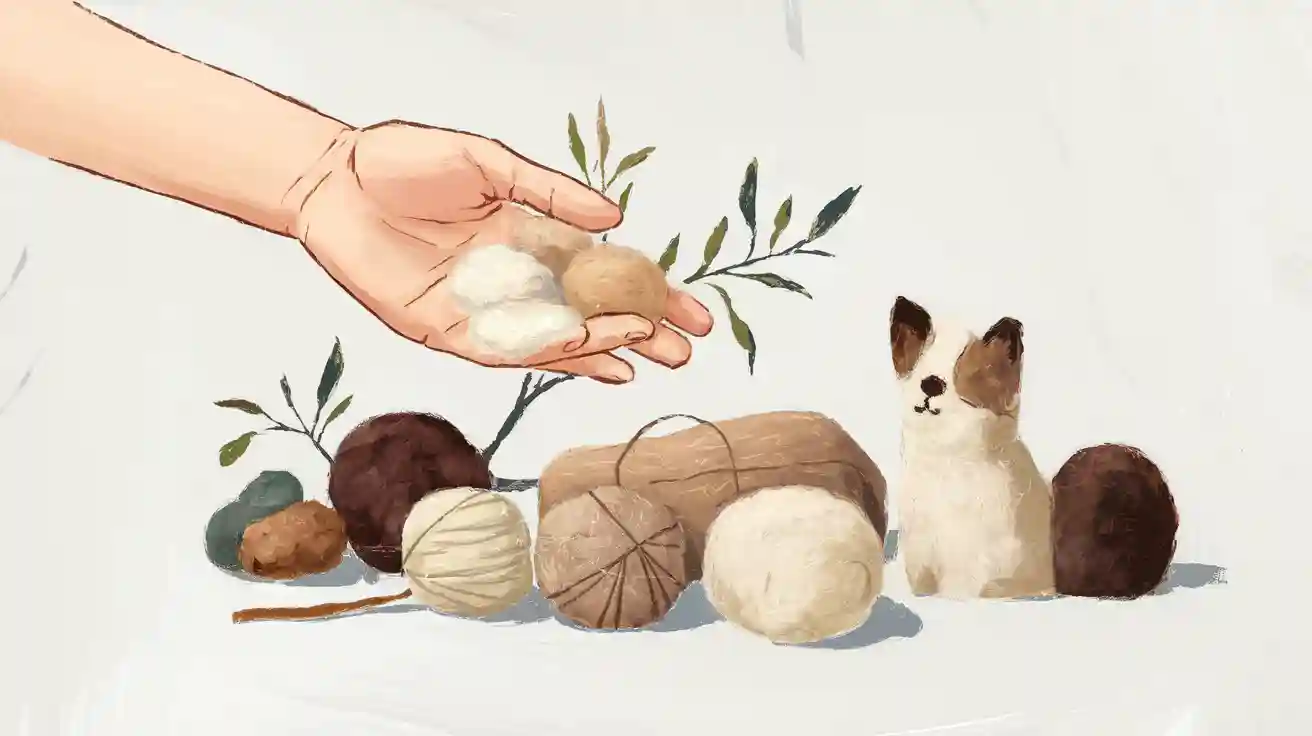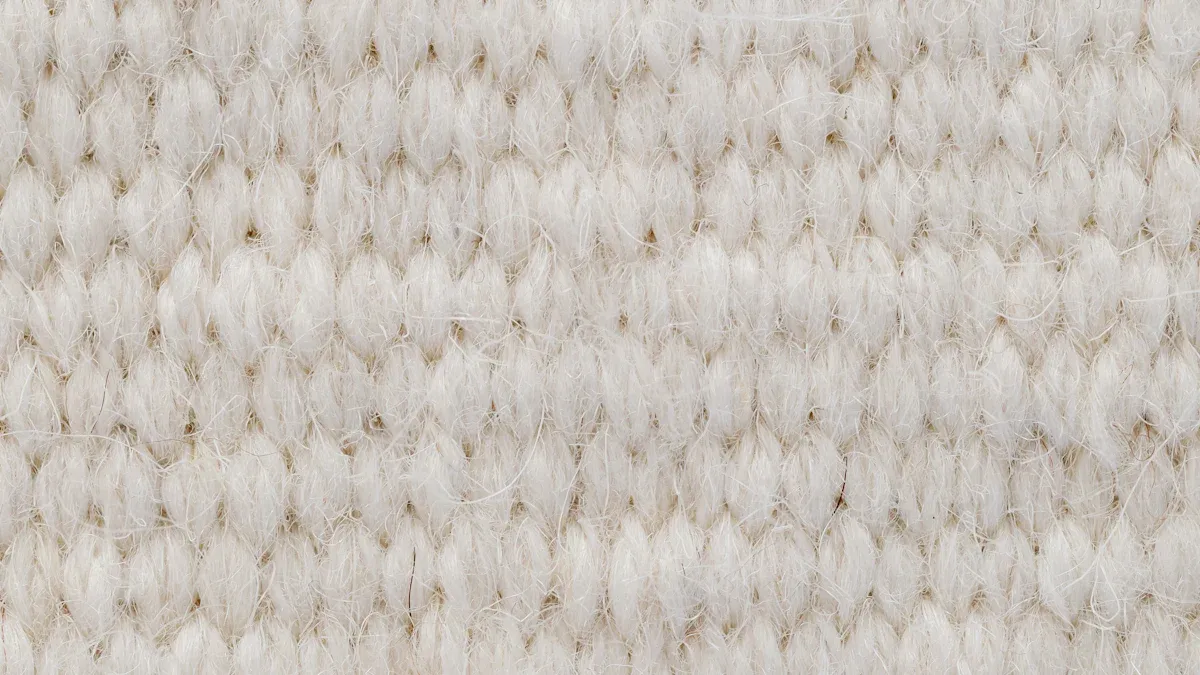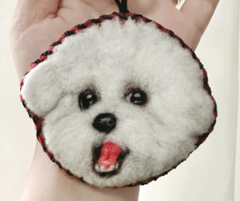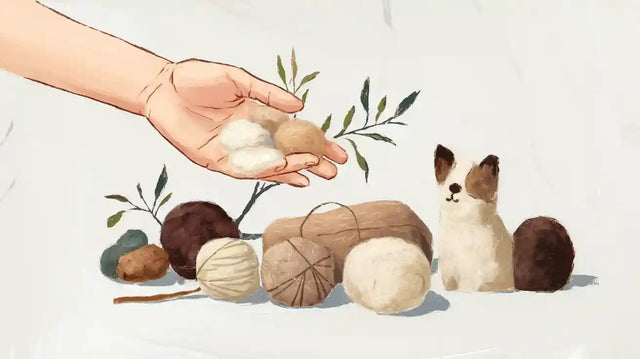Exploring the Natural Fibers Used in Pet Wool Felt

You can find pet wool felt made from natural fibers. These include Merino, Romney, and Corriedale sheep wool. Other fibers are alpaca, mohair, and yak hair. These fibers are soft, warm, and strong. Alpaca wool is light and keeps away moisture. Yak wool is warmer and fights germs. Picking the right fiber is important for custom wool felt art. This includes portraits, keychains, and photo frames. Artists test each fiber for comfort and safety. They follow rules set by the industry. Pawimprint uses trusted sources to make special keepsakes. These keepsakes are high quality and make customers happy.
Key Takeaways
Pick natural fibers like Merino, Romney, and Corriedale for pet wool felt. These fibers are soft, strong, and comfy for keepsakes.
Alpaca and yak wool have special benefits. They are lighter and warmer than other fibers. They are also less likely to cause allergies. This makes them good for pet keepsakes.
Mixing different fibers makes felt better. If you mix sheep wool with alpaca or mohair, the felt feels nicer. It also lasts longer and looks better.
Check for certifications like the Responsible Wool Standard. This shows the wool comes from farms that treat animals well. It also means the farms care about the environment.
Trust skilled artisans to make custom pet keepsakes. They test each fiber to make sure it is safe and high quality. This helps your keepsake last long and look nice.
Raw Materials Used in Pet Wool Felt
When you look at pet wool felt, you find many raw materials. Artists use these to make special keepsakes for pets and people. These materials come from different sheep wool and other animal fibers. Each type gives something special to the finished item. Artists pick and test each fiber to make sure it is safe and comfy.
Sheep Wool Varieties
Sheep wool is the most common choice for pet wool felt. There are three main sheep breeds used: Merino, Romney, and Corriedale. Each breed has its own features. These features change how the felt looks and feels.
Fiber Characteristics |
Suitability for Felting |
|
|---|---|---|
Romney |
Long, semi-lustrous fibers |
Firm yet soft surface, super-durable |
Merino |
Ideal for soft textures and wet felting |
|
Corriedale |
Springy texture, medium-coarse |
Excellent for needle felting, quick felting properties |
Merino wool feels very soft and gentle. Its fine fibers are great for soft projects. Romney wool has longer, rougher fibers. This makes felted items strong and tough. Corriedale wool is in the middle. It is soft but also holds its shape well. Many artists like Corriedale for needle felting. Its springy texture helps needles grab the fibers.
Sheep Breed |
Fiber Diameter (microns) |
Staple Length (mm) |
Characteristics |
|---|---|---|---|
Merino |
17-25 |
Shorter |
Soft, delicate |
Romney |
33 |
150-200 |
Coarse, durable |
Corriedale |
25-32 |
~150 |
Medium, balanced |
You can see that fiber size and length matter. Merino wool is fine and short, so it makes soft felt. Romney wool is thick and long, so it is strong. Corriedale is in between, so it works for many projects.
Pawimprint gets these materials from trusted farms. They check each batch for quality and safety. Many farms follow rules like the Responsible Wool Standard and ZQ Certification. These rules make sure sheep are treated well and farms are good for the earth.
Wool production releases methane, a strong greenhouse gas. This gas is much stronger than CO2. Wool has a bigger effect on the environment than some other materials. The amount of emissions depends on how farms are run. Natural grazing can help soil health. Sheep are part of the natural carbon cycle. Their methane is not like fossil fuels, which add new carbon to the air.
Alpaca and Other Animal Fibers
Alpaca, mohair, and yak hair are also used in pet wool felt. These fibers have special benefits that make them different from sheep wool.
Fiber Type |
Softness |
Micron Count |
Insulation |
Breathability |
Antibacterial Properties |
|---|---|---|---|---|---|
Alpaca |
Softer than cashmere |
Medium-weight |
High insulation |
Excellent |
Yes |
Mohair |
Softer due to smaller scales |
Varies |
Good |
Good |
Yes |
Yak |
Comparable to cashmere |
About 18.5 |
High |
Good |
Yes |
Sheep Wool |
Standard softness |
Varies |
Moderate |
Moderate |
No |
Alpaca fibers are softer and lighter than sheep wool. They keep warmth in and let air flow through. Mohair comes from Angora goats and is softer because of its tiny scales. Yak hair is as soft as cashmere and keeps things warm. These fibers also fight germs, so keepsakes stay fresh and safe.
Artists often mix these animal fibers with sheep wool. This helps them get the best results. You see this in custom portraits and keychains. Pawimprint works with skilled artists who test each fiber. They check for comfort and strength. They use outside sources and follow industry rules to make sure every batch is good.
More artists now use eco-friendly materials for pet wool felt. Many pick sustainable wool felt because it is natural and breaks down over time. The market for custom pet portraits is growing. More pet owners want special art that shows their pets’ personalities.
You can trust that the raw materials come from good sources. Artists and brands like Pawimprint care about where they get their materials. They test for quality and work with experts. This makes sure every keepsake is safe, comfy, and lasts a long time.
Why These Raw Materials Are Chosen
Comfort and Safety
You want your pet’s keepsake to feel soft and safe. Artists pick natural fibers like wool, alpaca, mohair, and yak hair. These fibers have special features that make them great for pet wool felt.
Alpaca wool is lighter than sheep wool. It keeps warmth in better. Its hollow fibers trap air. This helps keep things warm. Alpaca can soak up a lot of moisture. It can hold up to 30% of its weight. It does not feel wet. This makes it comfy and helps control humidity.
Yak wool has crimped fibers. These trap air and give good insulation. Yak and alpaca wool help keep the keepsake at the right temperature.
Some people worry about allergies. Alpaca and yak wool have less lanolin than sheep wool. This means they are less likely to cause allergies. They do not hold much moisture. Bacteria do not grow easily. Yak wool has a low moisture regain of 15.6%. Alpaca wool is water-repellent. This keeps the felt dry and safe.
Alpaca is softer to touch than Merino wool. More people react to alpaca than Merino. Comfort depends on fiber diameter and structure. Finer fibers are usually more comfortable. Untreated alpaca can be less itchy. It has smoother scales than Merino. Comfort can change based on fiber quality and treatment.
Pawimprint artisans test each batch of wool and other fibers. They check for softness, safety, and comfort. They use their skills and expert advice. This makes sure every keepsake is gentle for you and your pet.
Durability and Longevity
You want your keepsake to last a long time. Felting makes wool fibers lock together. This creates strong and sturdy material. Sheep wool from Romney and Corriedale breeds gives strength and shape. Alpaca and yak fibers add warmth and softness. They also help the felt resist wear.
Wet felting blends these fibers. This makes the finished product tougher. Mohair from Angora goats adds shine and flexibility. Mixing fibers means your keepsake will look nice for years.
Artisans use their hands and eyes to test each piece. They check for strong bonds between fibers. They make sure the felt does not pull apart. Experts say natural wool felt lasts longer than synthetic felt. It keeps its shape better. You can trust your custom portrait or keychain will last.
Impact of Raw Materials on Pet Wool Felt Products
Quality in Custom Portraits and Keychains
The type of wool used changes how pet wool felt looks. Pawimprint artists use many kinds of wool felt. They make custom portraits, keychains, and photo frames. Good wool makes a big difference in the final product. Merino wool helps artists show small details and smooth color changes. Corriedale wool gives the keepsake a strong shape. When artists layer these fibers, the portrait looks real and full of life.
Merino wool helps show tiny details, like shiny eyes.
Corriedale wool keeps the shape strong and firm.
Organic merino wool feels soft and stays strong for years.
Wool’s lanolin keeps water away, so portraits stay fresh.
Carded wool batts help blend colors for a smooth look.
Pawimprint artists check each batch of wool felt before they start. They talk with customers and listen to what they want. Customers share thoughts about softness, color, and how long it lasts. Many people say their portraits look just like their pets. This feedback helps artists get better and pick the best wool.
Safety and Practicality for Pets
You want your keepsake to be safe and easy to clean. Wool felt from animal fibers is safe and not toxic. The Responsible Wool Standard makes sure farms treat animals well. If you pick RWS Certified wool, you help support good care for animals.
Wool felt is safe for you and your pets.
RWS means the wool meets strict safety rules.
Eco-friendly wool felt helps protect the earth.
Different fibers give pet owners helpful features. The table below shows how wool felt and other things help with allergies and moisture:
Description |
Benefit |
|
|---|---|---|
Allergen reduction |
||
Dusting with sticky cloths removes allergens from surfaces |
Allergen management |
|
Washing pets every week lowers airborne allergens |
Moisture management |
|
High-efficiency vacuums lower allergen exposure at home |
Allergen reduction |
Wet felting and natural wool felt make cleaning simple. Wool felt does not soak up much water and keeps its shape. This means your keepsake stays nice for a long time. Pawimprint works with skilled artists and listens to pet owners. Picking the right materials makes products safe, useful, and long-lasting.
Comparing Animal Fibers in Pet Wool Felt

Texture and Appearance
When you pick wool felt for pets, you see each fiber looks different. Sheep wool, like Corriedale, comes in many natural colors. These colors look like those in nature. This makes felt items look real. Corriedale wool has crimp and texture. This adds depth and makes portraits and keychains stand out.
Alpaca fibers are softer and warmer than sheep wool. Alpaca felt has a gentle shine. This gives keepsakes a fancy look. Mohair from Angora goats drapes well and feels silky. Yak hair is as soft as cashmere. It makes the surface plush. Each fiber gives its own style to felting.
Corriedale wool has mixed and solid colors. This gives more variety.
Alpaca felt is lighter and smoother. It works well for small details.
Mohair adds shine and a soft finish.
Yak hair makes a rich, warm texture.
You can notice these differences in finished items. Artists at Pawimprint test each batch. They make sure every keepsake has the best texture and look.
Suitability for Different Pet Products
You want your keepsake to last and be safe. The materials you pick change how strong and safe it is. Experts suggest certain fibers for different items. The table below shows how each fiber works:
Wool Type |
Durability |
Texture |
Safety |
|---|---|---|---|
Sheep Wool |
Durable, warm |
Standard texture |
Not specified |
Alpaca |
Softer, stronger than cashmere |
Medium-weight, warmer, lighter |
Hypoallergenic |
Mohair |
Long-lasting, strong |
Luxurious, drapes nicely |
Not specified |
Yak Hair |
Comparable to cashmere, insulating |
Plush, rich |
Hypoallergenic |
For portraits, short-fiber wool like Merino and carded batts help show fine details and blend colors. Corriedale wool gives strength and shape. This makes it good for keychains and photo frames. Wet felting mixes these fibers. This makes keepsakes tough and pretty.
Wool Fibers |
Specific Materials/Types |
Effect on Durability and Suitability for Pet Portraits |
|---|---|---|
Wool Fibers |
Fine detail, color blending, strong structure |
You get help from artists who test fibers and use expert advice. Pawimprint gets wool felt from trusted farms and follows rules. This makes sure your keepsake is safe, strong, and looks great.
You can pick from many types of pet wool felt. Good choices are Merino, Romney, and Corriedale wool. Alpaca, mohair, and yak hair are also used. These fibers help make felt soft and strong. They keep custom pet items safe. Mixing special fibers with wool makes felt last longer. It also helps felt look nice for a long time. Always check if the wool felt is comfy and good quality. Experts say wool felt is tough and easy to clean. Pawimprint uses skilled workers and the best materials. This helps keepsakes stay nice for years.
Aspect |
Description |
|---|---|
Craftsmanship |
|
Material Quality |
Only pure natural wool felt is used for softness and safety. |
Customization Options |
Many frame sizes, colors, and styles fit your needs. |
Tip: Pick wet felting and natural fibers for the best pet wool felt.
FAQ
What animal fibers do you find in pet wool felt?
You can find Merino, Romney, and Corriedale sheep wool. There is also alpaca, mohair, and yak hair. Artists pick these fibers because they are soft and strong. They also want the keepsakes to be safe. Trusted farms supply the fibers. Artisans test them to make sure they are good quality.
Is pet wool felt safe for pets and people?
Natural fibers make these products safe for everyone. The Responsible Wool Standard and ZQ Certification help protect animals. Experts and artisans check each batch for comfort and safety. You can trust these keepsakes are safe to use.
How do you clean wool felt pet keepsakes?
Use a soft brush or cloth to clean dust. Gently wipe with mild soap and water if needed. Do not soak the felt. Wool felt does not hold much water and keeps its shape. Experts say gentle cleaning helps keepsakes last longer.
Why do artists mix different animal fibers?
Mixing fibers gives better texture and makes items last longer. It also helps the keepsakes look more real. Using Merino, Corriedale, and alpaca together helps make lifelike portraits. Artists use their skills and expert advice to pick the right fibers.
Where does Pawimprint source its wool felt materials?
Pawimprint gets wool felt from certified farms and skilled artisans. They follow rules like RWS and ZQ. Trusted sources and careful testing make sure every keepsake is high quality.

